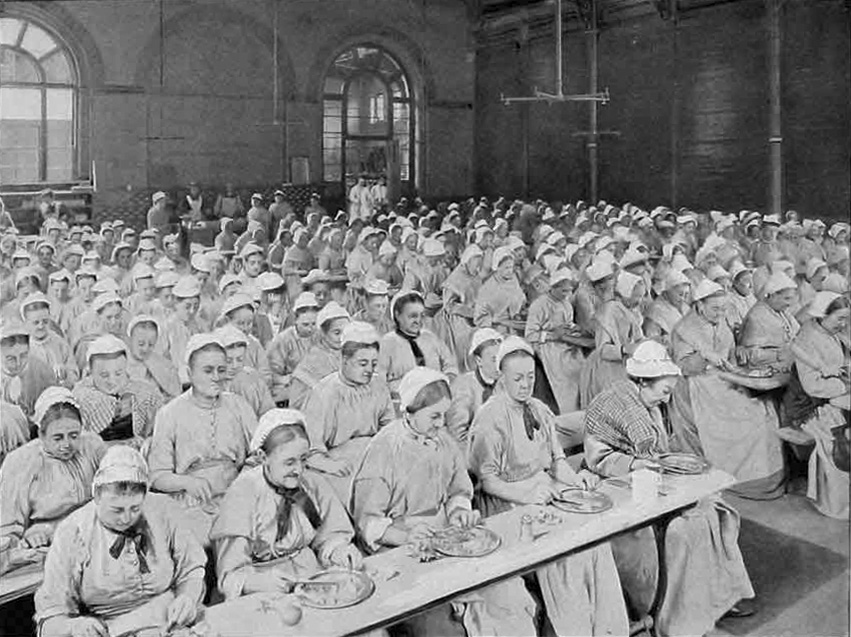
What was the workhouse? It was a place where people who could not support themselves financially could live. They existed from 1388 to 1948.
Every country and every city has people that live below the poverty line, for many different reasons. These days, we live in a society where there is some help for these people, although not nearly as much as is needed. The idea of modern society is to tax the rich in order to help the poor, creating as much equality as possible. This is a long way from actually happening, but it means that we don’t have institutions like workhouses anymore. In a modern society, most people who go below the poverty line, do so temporarily. The idea of welfare is to help them get through the times when things are tough and help them on the road to recovery. Most people do not take benefits indefinitely.
Workhouses first appeared in 1388 in England. They were set up as a place for poor and destitute people to live if they couldn’t afford to support themselves. They weren’t a new concept, but they were state run, which was a new concept. From approximately the 10th century, there were almshouses where poor people could go for food and shelter. They were run by churches and other religious institutions. The people who stayed in them had to pray for the founder of the institution. Almshouses still exist today.
In 1388, the state set up some workhouses to take care of poor people. This came about because of the Black Death and the Poor Law Act of 1388. The Black Death decimated populations in Europe and there was a huge labor shortage. The state was worried that if laborers were allowed to move to different towns in search of better paid work it would drive up the price of labor and cause an economic crisis, so they banned people from leaving their parishes. That meant poor people couldn’t go in search of better work. The state had passed the law, so these poor people became the state’s problem.
The workhouse system evolved through the 16th century, with responsibility being passed to each individual town. More laws were passed in the 17th and 18th centuries, setting up the concept of the workhouse as it would become known. People who couldn’t support themselves were required to enter a workhouse. The living conditions were terrible and they were forced to work long hours for no pay. This meant that once someone entered a workhouse, there was no real way for them to get out and they often became prisons for the poor.
Workhouses came into their own in the Victorian era and are synonymous with that time. In 1834, the Poor Law Amendment Act was passed. After the Napoleonic wars, and possibly due to mechanization in industry, there were a large number of unemployed people. Workhouses were becoming profitable businesses because they were a source of free labor and the government was also supporting them. The government decided to crack down. The new law demanded that anyone that couldn’t support themselves had to enter a workhouse, where conditions were terrible. The workhouses were divided by gender and age, so families were forcibly split up. Inmates were not allowed to talk to each other and when they were not sleeping, they were working. The idea behind the Victorian workhouse was that people had fallen on hard times because they were lazy and they needed to be punished. There were 8 to 10 beds in a room and rodents and disease were rife. Death rates were higher than in regular society. Possibly as many as 10% of the people who entered the workhouse died there.
By the end of the 19th century and into the early 20th century, people had started to turn against the idea of the workhouse and the thought that poverty was down to laziness began to change. In 1929, in England, legislation was passed that would turn the workhouses into hospitals. In 1948, the National Assistance Act was passed, which was hoped to solve the problem once and for all. Workhouses were closed, or repurposed. The law introduced welfare for people who couldn’t afford to support themselves.
The problem of poverty has not gone away and governments still don’t seem to know what to do, but the idea that poverty is down to laziness and that poor people should be locked up and punished has gone. And this is what I learned today.
Image By Unknown, circa 1911 – http://www.cqout.com/item.asp?id=4872846, Public Domain, https://commons.wikimedia.org/w/index.php?curid=16857770
Sources
https://en.wikipedia.org/wiki/Workhouse
https://en.wikipedia.org/wiki/National_Assistance_Act_1948
https://en.wikipedia.org/wiki/Pensions_in_the_United_Kingdom
https://www.historic-uk.com/HistoryUK/HistoryofBritain/Victorian-Workhouse/
